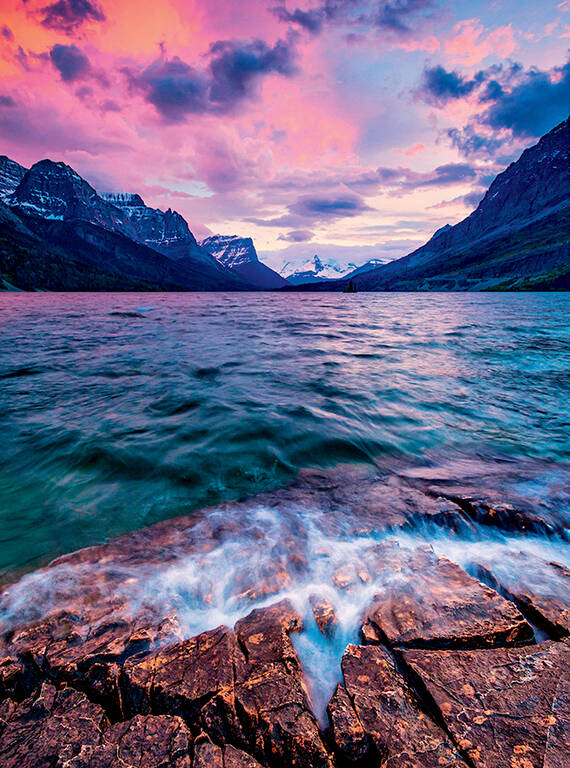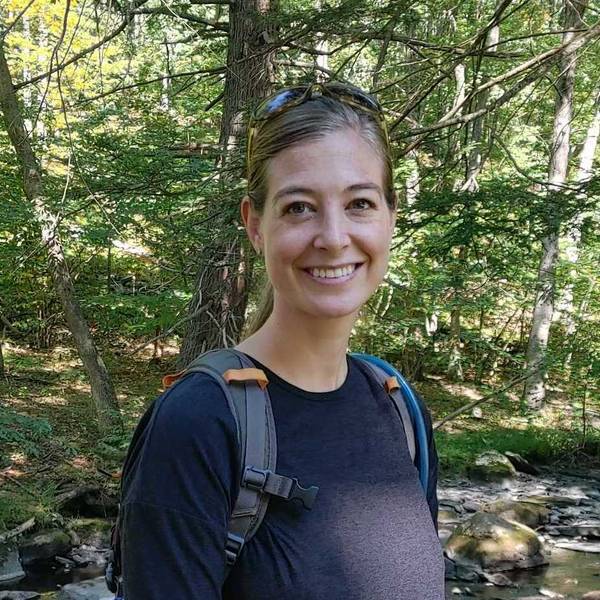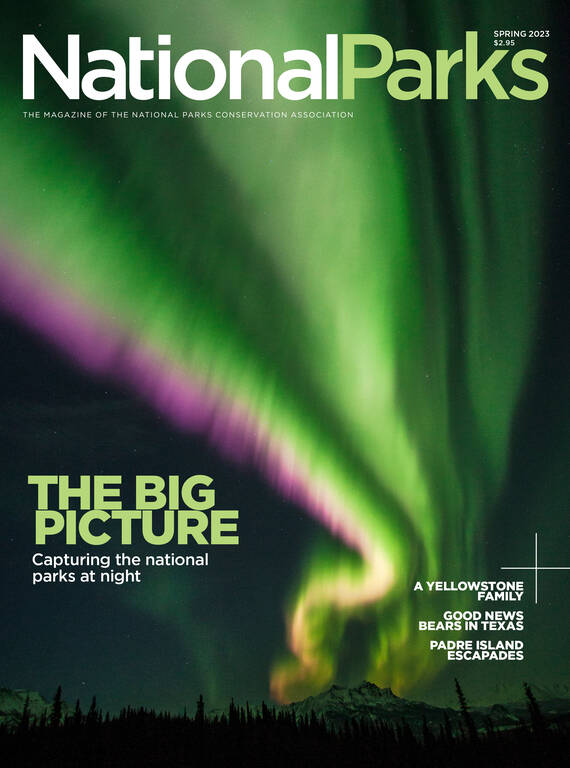Spring 2023
Reservations Required?
A last-minute trip challenges one planner to explore Glacier without a Going-to-the-Sun Road vehicle pass.
On a sunny afternoon in late August, I found myself sitting in the passenger seat of a white Corolla, waiting to enter Glacier National Park through the West Entrance. Andi, sunglasses propped atop her pixie cut, was driving. Having traveled more than 2,200 miles that day, we were antsy to make it to the Apgar Visitor Center, a mere 2 miles away. Once there, we’d hop on the free shuttle bus, bouncing our way up the scenic Going-to-the-Sun Road to our final destination: the Avalanche Lake trailhead.
There was a small line of cars ahead of us, queued up at the park’s guard station. We watched, dispassionately, as a couple of drivers U-turned and headed past us. A ranger, looking tired and besieged, approached my window. “Do you have a reservation?” he asked. “No,” I told him. “We just want to park at Apgar.” He shook his head and informed us that we needed a ticket for the Going-to-the-Sun corridor even to reach the visitor center, which is near where the road starts. He instructed us to turn around.
I was confused and a little miffed. I’m a planner. That’s my thing. I had looked at the map; I had read the information on the website. How did this happen? As I ranted, Andi pulled a U-ey and drove to the small hub of stores in the unincorporated gateway of West Glacier. We needed to regroup.
It had all started a few weeks earlier when my husband came home with a proposition. His colleague, whom I’d met once, was planning a trip to Glacier and was looking for a travel buddy. “This is right up your alley,” he said. “You’ll love Andi.”
The idea of a quick trip from muggy Virginia to northwest Montana was terribly appealing. Plus, I like to think I’m a naturally adventurous person. In that exact moment, though, the unknowns snowballed. Did she have a reservation for the Going-to-the-Sun Road? A campsite? A rental car? Underlying that was another concern: Would Andi and I get along?
Turns out, Andi hadn’t booked anything aside from her flight. She was hoping for a hotel room because she hadn’t camped in ages. She’d heard about a reservation system but hadn’t looked into it yet. (No matter, because all the early-bird tickets had disappeared months before. We now had to wait for the second window to open, just 24 hours out, and bank on a surfeit of luck.) She also didn’t know what she wanted to do there but was up for anything. Hiking? Of course. Stand-up paddleboard? Sure! Bison burgers and venison jerky? Why not?!
Andi is the free-spirited yin to my organized yang. Where I foresaw a crucible, she predicted excitement. Could we combine our strengths and explore Glacier without that coveted pass?
Sitting at a picnic table in West Glacier after our inauspicious arrival, I had deep misgivings. But I took my cue from Andi, who appeared unruffled as she snacked on huckleberries. We twiddled our thumbs for an hour, then climbed back in the car at 4 p.m., when reservations were no longer required. After creeping through the unstaffed entrance station, we parked at the visitor center, stepped onto the waiting shuttle and turned to each other in relief: victory.
Despite its jaw-dropping landscape, Glacier has never garnered the same attention as its park sister to the south, Yellowstone. Part of that is due to its relative inaccessibility. With few easy hikes and fewer roads, it’s a park that demands a little more of its visitors. The only road that truly bisects the park is the roughly 50-mile Going-to-the-Sun Road, which climbs more than 3,400 feet in elevation and crosses the Continental Divide. An engineering marvel, the road — in all its hairpin, vertiginous glory — was completed in 1933 and designed to blend seamlessly into the mountainside. Unsurprisingly, some 70% of all Glacier visitors tour Going-to-the-Sun, pulling off at various overlooks to marvel at what the Blackfeet call the Backbone of the World.
We’ve seen fistfights in parking lots over parking spaces.
Though annual visitation has trended upward since the park’s designation more than a century ago, it mostly hovered around 2 million for several decades until 2014 when visitation, park system-wide, began to surge. Glacier, a 1-million-acre park with some 2,000 parking spots along the main corridor, experienced a 40% jump in yearly visitors between 2015 and 2017. Seemingly overnight, rangers became traffic cops. Then the pandemic hit, and people rushed to Glacier in even greater droves once the park reopened.
“You could pull up to get into the park at West Glacier and the gate could be closed and traffic could be backed up for 3 or 4 miles down the highway,” said Sarah Lundstrum, NPCA’s Glacier senior program manager and member of an internal team focused on park visitation woes. “We’ve seen fistfights in parking lots over parking spaces.” This kind of congestion isn’t just an annoyance. Because rescuers can’t get through on crowded trails and gridlocked roads, “they’re flying people out for things like a sprained ankle or a twisted knee,” Lundstrum said.
Wayne Freimund, a professor of environment and society at Utah State University, said relieving the pressure at Glacier is inherently tricky. “The park is not only a park,” he explained. “It’s proposed wilderness, a biosphere reserve, an international peace park and an international dark sky park, and it has wild and scenic rivers wrapping around it. So there’s a lot of layers of concern at Glacier that, I think, make it a little more complicated than, ‘Well, we’ll just add more parking lots.’”
Ultimately, public safety forced the park’s hand in 2021. The Montana Department of Transportation informed the park that its miles-long traffic snarls had to stop during planned construction on the highway outside of Glacier’s West Entrance. With summer approaching, park managers hastily piloted a ticketed-entry system.

Sunset on St. Mary Lake.
©TOMAS NEVESELY/SHUTTERSTOCKThe plan was simple enough. For $2, visitors could reserve a pass to access the Going-to-the-Sun corridor during the busy summer season. Those uninterested in purchasing a pass (or those like Andi and me who failed to procure one) could find park-sanctioned workarounds. Namely, you could reserve a campsite, stay at a lodge or book a recreational activity within the corridor, and that would come with access to the road. You could visit other places within the park, which we did, or drive into the park before or after the reservation window, which we also did. Failing that, you could leave your car behind and walk into the park.
Glacier isn’t the only park to flirt with managed access in recent years. Park managers systemwide wrestle daily with the complex questions spurred by an adoring — and growing — fan base. How can parks champion accessibility, encouraging all people to enter their gates, while preserving the experiences (such as solitude) that visitors most value? As forces such as climate change and development threaten parks from without and opposing camps battle over appropriate recreation within, how can managers continue to protect park resources and allow for the public to enjoy them? Lacking an easy solution, half a dozen sites from Acadia National Park in Maine to Muir Woods National Monument in California have piloted some sort of reservation system, whether for parking spots, specific trails or general park entry.
Freimund, with backing from NPCA, spent the summer of 2021 surveying visitors at Glacier and last summer at Arches National Park to understand public perception of these new systems. By and large, participants were supportive of the reservations. “We’re seeing folks who, I think, are seeking this predictability,” Freimund said. “They can do what they planned to do when they planned to do it.”
Invariably, Glacier’s system has its detractors. Freimund’s team collected complaints about everything from the confusing process to the difficulty of procuring tickets. If you scan Google, you’ll find naysayers objecting to the inconvenience of buying passes online. That said, nearly all of the 15,000 reviewers, even the frustrated ones, give the park five stars. Despite the extra hoops, people still flock to the park — and enjoy the less crowded atmosphere once there.
To be sure, these pilot efforts are works in progress, Lundstrum and Freimund said. Based on lessons learned in 2021 (namely, if you restrict access to one area, other areas will see unsustainable levels of visitation), Glacier’s reservation system expanded in 2022 to include ticketed entry at the Polebridge Ranger Station. And new this July, reservations will be required for the Two Medicine and Many Glacier areas of the park. Gina Kerzman, the park’s public information specialist, said the system is working. “We’ve been able to spread crowds out,” she said.
If I were to return to Glacier this August, my park calculus would look a little different. As it was, Andi and I settled into a companionable rhythm of planning only so far as the next meal was concerned. Each night, over ruby-red hard ciders or food truck quesadillas, we weighed our morning options. Go in early or drive to a portion of the park that didn’t require a reservation? Each lunch, we’d hash out an afternoon action plan. Hike here or there? Drive up, down or around? And, every time we had cell phone service, we’d check Recreation.gov on the off chance tickets for the following day were available. (Spoiler: We rarely did — and they never were.)
For our first full day, we headed to the then-reservationless Two Medicine, where we’d been told alpine views were plentiful and we could take a ride on Sinopah, a nearly 100-year-old wooden boat. Despite mistiming our hike to the picturesque No Name Lake and having to run the last 1.5 miles — boots thumping, water bottles clanking — to catch the next boat back to our car, Two Medicine did not disappoint.

National Parks
You can read this and other stories about history, nature, culture, art, conservation, travel, science and more in National Parks magazine. Your tax-deductible membership donation of $25 or more entitles…
See more ›The following day we rose early, intent on entering the park before 6 a.m. With Orion overhead, we parked and walked to the chilly edge of Lake McDonald. The mountains, like ink blots, remained black and impassive as the sky transitioned from pearl to blush to fire. To my right, I noticed a line of red taillights marching along the Going-to-the-Sun Road, all entering — like us — unimpeded by park staff.
On our last day, during an unexpectedly lovely hike on an unassuming trail, I reflected on all that Andi and I had managed to see and do. We’d snacked on peaceful lakeshores and stumbled upon hanging valleys. We’d watched a man square off with a bighorn sheep and snapped selfies as the sun cast gold over the mountains. We’d recharged with chai lattes and unwound over gooey huckleberry cobbler. We’d paddled across morning-still water, listened to the piercing cry of a golden eagle and trailed our hands along late-blooming flowers. We’d even managed to drive the entirety of the Going-to-the-Sun-Road, without rankling any more rangers. We weren’t always successful in these semi-spontaneous schemes (case in point: our bumbling detour along a manure-caked horse trail), but we pushed ahead and freed ourselves to be surprised by chance.
To learn about national park reservations for 2023, visit npca.org/reservations.
About the author
-
 Katherine DeGroff Associate and Online Editor
Katherine DeGroff Associate and Online EditorKatherine is the associate editor of National Parks magazine. Before joining NPCA, Katherine monitored easements at land trusts in Virginia and New Mexico, encouraged bear-aware behavior at Grand Teton National Park, and served as a naturalist for a small environmental education organization in the heart of the Colorado Rockies.



